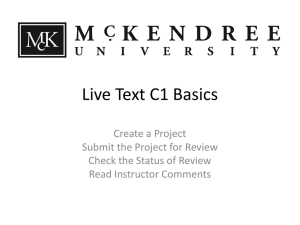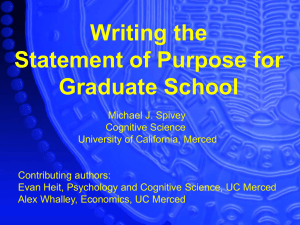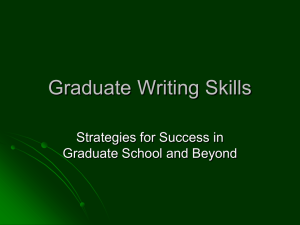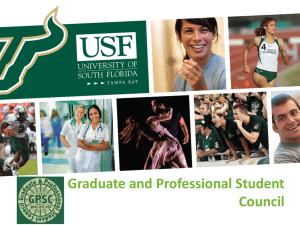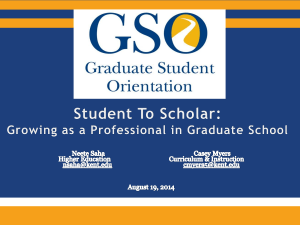Document
advertisement
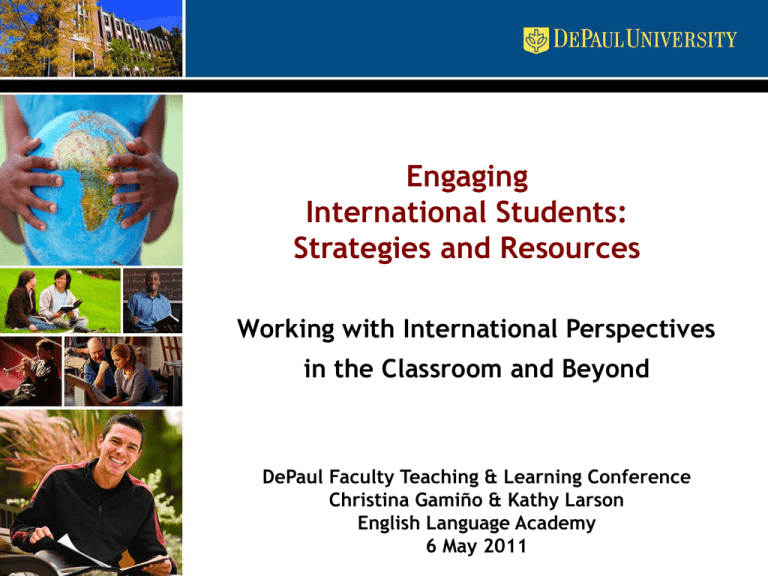
Engaging International Students: Strategies and Resources Working with International Perspectives in the Classroom and Beyond DePaul Faculty Teaching & Learning Conference Christina Gamiño & Kathy Larson English Language Academy 6 May 2011 Rough outline of our discussion this afternoon: 1. Who are DePaul’s international students? 2. Academic, linguistic, social challenges 3. Strategies and resources to assist DePaul International Students • • • • 1,124 students from 98 countries May have university degree from home country May possess significant professional experience May return to a high-level government post or corporate job • Level of study: – Undergraduate: 241 – Graduate: 683 (primarily CDM & KGSB) – Non-degree & ELA: 200 (21 +179) – Total: 1,124 Top Countries Represented at DPU • • • • • • • • • • 197 from China 131 from India 101 from Saudi Arabia 92 from Thailand 65 from S. Korea 55 from Taiwan 36 from Canada 35 from Pakistan 19 from Turkey 18 from Russia – – – – – – – – – – primarily primarily primarily primarily primarily primarily primarily primarily primarily primarily graduate graduate graduate & ELA graduate & ELA ELA & undergrad graduate graduate graduate graduate & ELA undergraduate Challenges for International Students Culture Shock: Navigating University Culture (legalities, procedures, etc) Culture Shock: Adjusting to Life in the U.S. Culture Shock: Adjusting to Life in the U.S. Classroom Survey of Academic Culture in the U.S. Classroom Please rate the following behaviors as acceptable or unacceptable. Asking the professor questions during class time Acceptable Unacceptable A professor responding “I don’t know” to a student’s question Acceptable Unacceptable Students offering personal comments/views during discussions Acceptable Unacceptable Students disagreeing with the professor (in class) Acceptable Unacceptable Using the professor’s first name Acceptable Unacceptable Arriving late to class Acceptable Unacceptable Using text from the internet in a research paper (without citation) Acceptable Unacceptable Understanding the U.S. Classroom Learning Environment Aspect Teacher-Centered Approach Learner-Centered Approach Preferred Teaching Methods Lecture Lecture, discussion in large and small groups Instructor’s Role Direct the learning process, be source of knowledge, clarify and interpret written texts Learner’s role Listen to lectures, take notes, read assigned texts, memorize content, demonstrate memorization through tests and written papers Listen, take notes, read, think critically about content, express perspectives in class, participate in dialogue, demonstrate understanding Who directs learning process Instructor Instructor and student Instructor/Learn er Relationship Formal Sometimes informal and cooperative Present content, facilitate dialogue, demonstrate analytical skills Understanding the U.S. Classroom Learning Environment Aspect Teacher-Centered Approach Learner-Centered Approach Use of the computer and internet Considered only as an adjunct to the lecture Can be an intrinsic part of achieving the course objectives, and used by the professor to engage the students in further exploration of the topic as well as out of class discussion topics Learning mode Top down (i.e., instructor imparts knowledge to students) Cooperative, participatory, discussionoriented, interactive between instructor and learner Evaluation methods Written and oral exams Written and oral exams, case studies, presentations, class participation, papers, quizzes, group projects, classmates’ evaluations Who conducts evaluation Instructors evaluate students Instructors evaluate students, students evaluate instructors, classmates evaluate each other Research process Instructor directs research process Instructor guides process, but learners have more freedom in choosing topics Desired outcomes Memorize texts, absorb knowledge Gain knowledge, apply concepts to new situations, use critical analysis skills International Programs Office Summary of Challenges Students may be unfamiliar with: • Services available (academic advising, counseling, writing center) • Terminology (syllabus, GPA, drop/add, abbreviations) • Academic technology (D2L) • System of evaluation (class participation, group work, multiple choice) • Informal style of U.S. classrooms Summary of Challenges Students may: • hesitate to raise hand while professor is speaking • equate questions with offense/challenge to authority • lack confidence in English fluency (anxiety @ cold call, self-conscious @ word choice/accent) • see student role as passive recipient; may be surprised to be asked own opinion and defend views in discussion • not seek professor’s help or guidance • Be uncomfortable working in teams and giving feedback • Be unfamiliar with using critical analysis skills to challenge the professor and other students Some Strategies to Help Bridge the Gap: 1. 2. 3. 4. Encourage students to seek out office hours Outline expectations (grading, participation, citation) State when students may raise hand to ask questions Introduce students to style manuals (APA) and educational technology (D2L) 5. Define unfamiliar terms and acronyms (syllabus, GPA) 6. Allow students to tape lectures; record and post lectures on D2L 7. Help students find ways to connect (bio page on D2L, emails, group work) 8. Help identify academic advisor; suggest good questions to ask, help students know what advisors can and should be able to help with 9. Talk to students after class and during break – check in informally on how they’re doing, if they have any questions 10. Recognize alternate or informal forms of participation (online discussion, questions before/after class, office hours, email) Some Strategies to Help Bridge the Gap: 11. Incorporate all students’ international and cross-cultural experience in classroom discussion 12. Be explicit about the organization of class time, about the objectives for each class, assignment and how it relates to the larger course goals, and evaluation methods 13. Provide concrete examples of assignments – sample essay, summary, abstract, review – genre or format may be unfamiliar 14. First week self–introductions: Be specific about what you want students to say about themselves. Too vague: “Tell us about yourself.” 15. Try not to single out international students in class. They want to feel they are treated just like everyone else, but appreciate support or extra help through clear class lectures and assignments, sensitive and discrete assistance as needed in class (explain a cultural/historical reference, paraphrase an idiomatic expression, clarify instructions) Some Strategies to Help Bridge the Gap: 16. Provide explicit instruction/guidance on how to do group work, something they may not be familiar with. When appropriate, let students select group or team members they want to work with. Give them time to get to know classmates before selecting work groups. 17. Let students choose topics for research/presentation – provide suggestions and guidance. They may not have as much experience making independent choices. 18. Offer to review first drafts of assignments ahead of time; give feedback about content and language – suggest specific revisions/edits – Writing Center 19. Talk through the writing process with students who may be new to academic writing in English – brainstorming, organizing ideas, outlining, citations, etc. 20. Be aware of assumptions you make about what students do and don’t know about academic culture in the U.S. – be open to reexamining your assumptions and helping students do the same. Presenters • • • • • • • • • • Kathy Larson, Faculty, ELA, klarson@depaul.edu Christina Gamiño, Faculty, ELA, cgamino1@depaul.edu Khalid AlSameti, graduate, CDM Tamaki Ohno, graduate, KGSB Accounting Jia Wang, graduate, KGSB Accounting Yanyan Zhang, graduate, KGSB Accounting Tiffany Ma, graduate, Journalism Liu Chi, graduate, KGSB Accounting Zhan Wang, graduate, KGSB Finance Deniz Menemenci, College of Communication (Graduate) Observations and Assumptions International Programs Office An International Student’s Perspective: “The first time my professor told me: ‘I don’t know the answer – I will have to look it up,’ I was shocked. I asked myself, ‘Why is he teaching me?’ In my country a professor would give a wrong answer rather than admit ignorance.” (Iran) from L. Robert Kohls, Developing Intercultural Awareness: A Cross-Cultural training Handbook, 2nd ed. 1994 International Programs Office More Perspectives from International Students… “I was so surprised and confused when…the provost, in person, held the door for me in order to let me pass before he would enter the door. I was so confused that I could not find the words to express my gratefulness, and I almost fell on my knees as I would certainly do back home. A man who is by far my superior is holding the door for me, a mere student and a nobody.” (Indonesia) “The American seems very explicit; he wants a ‘Yes’ or ‘No’ – if someone tries to speak figuratively, the American is confused.” (Ethiopia) International Programs Office “Unfortunately, I’ve been given a bad impression by some American students who speak of their own country very badly, especially of its foreign policy. I know all the foreign policy of America isn’t good, but I did not want to be told so by a native. I hate people who speak badly of their own land, even if they speak the truth.” (Japan) “Once…in a rural area in the middle of nowhere, we saw an American come to a stop sign. Though he could see in both directions for miles and no traffic was coming, he still stopped.” (Turkey) ---See Quotations handout for more---
